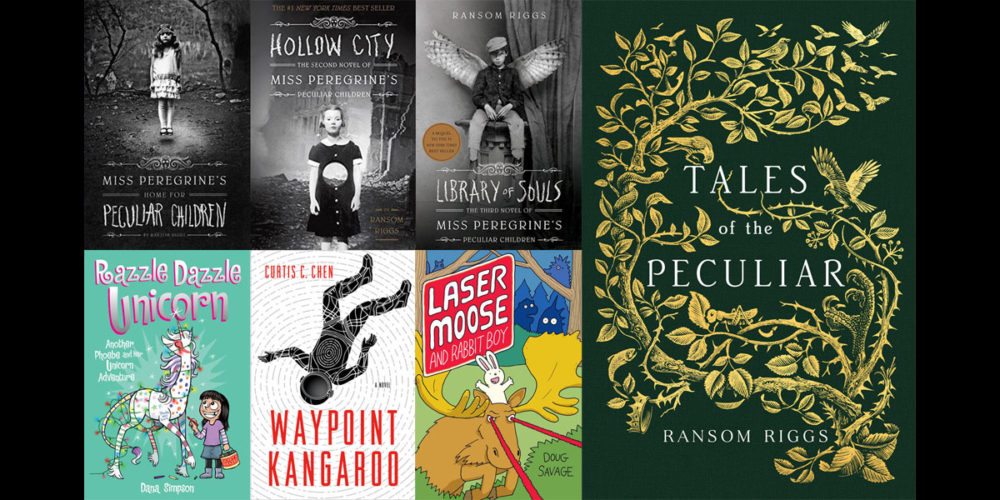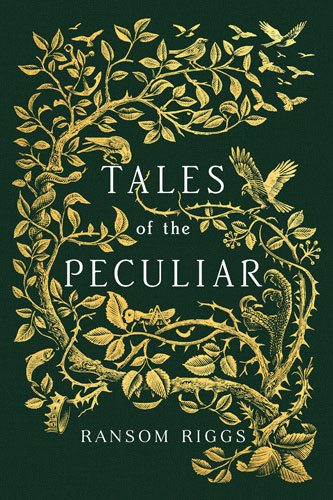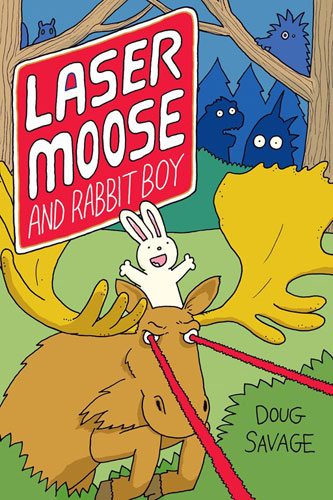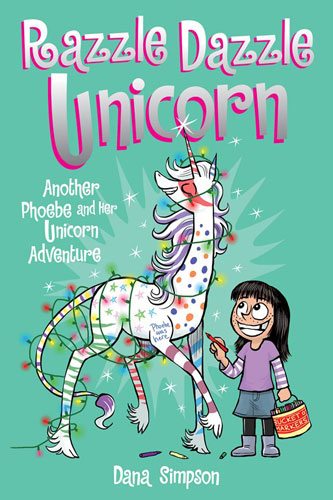In the past two weeks I finally got around to reading Ransom Riggs’ Peculiar Children series, as well as the companion book Tales of the Peculiar. In honor of the movie’s release this past weekend, today’s Stack Overflow will focus on my own selection of tales of the peculiar—starting, of course, with Miss Peregrine.
Peculiar Children trilogy by Ransom Riggs
A couple weeks ago I mentioned The Art of Miss Peregrine’s Home for Peculiar Children, about the making of the film version of the story. The art book does explicitly mention some of the changes from the book to movie—for instance, that they traded Emma’s and Olive’s powers—but they didn’t always point out places where the book and film diverge. Now, having read both the art book and the trilogy, I have a better sense of both the original story and the adaptation that Tim Burton has created. (And at some point I’m hoping to go see the movie, too.)
If you’re not familiar with the book series, it’s about peculiar children. In this world, “peculiar” doesn’t just mean a little odd or weird: it’s a bit more like the word “gifted” in “Xavier’s School for Gifted Youngsters.” Yep, all of these kids have powers or abilities or something extraordinary about them: Hugh has bees living inside him; Millard is invisible; Brownwyn is incredibly strong. Many of these abilities are, indeed, a lot like superpowers from comic books, but there are others that are even stranger. And the similarities with the X-Men doesn’t end there: in this world, you’re either born peculiar or you’re not, though your powers may manifest later. You don’t become peculiar by gamma radiation or anything like that.
Our introduction to this world is through the eyes of Jacob Portman, a teenager who grew up in Florida living a totally normal life. His grandfather, Abe, would tell him stories of battling monsters, of children with amazing abilities … but as Jacob grew older, he came to see all these stories as fairy tales, twisted memories of an old man who survived the atrocities of WWII. Of course, it may come as no surprise to the reader that all of his grandfather’s stories were true—as Jacob begins to understand when he finds his grandfather dying from a mysterious attack. His last words are cryptic, but they eventually lead Jacob to search for the truth of who his grandfather was, and what actually happened. Along the way he discovers his own brand of peculiarity, falls in love, and even does a little bit of time travel, of a sort. (This last bit: I won’t get into it in detail, but I did enjoy the way Riggs played around with time, even if it seemed like there were a couple of inconsistencies now and again. It does lead to some uncomfortable questions about the romance plot which may be best left unasked.)
The story of how this book came to be (as documented in The Art of Miss Peregrine) is pretty fascinating. Ransom Riggs likes to collect vintage photographs. At one point, he had talked to Quirk Books about publishing a collection of these photos, accompanied by short poems about each character. But soon the publisher was convinced that these photos needed more than just poems, and offered Riggs a contract to write a full-length novel, despite the fact that he had never written a book before. Their confidence in him, it seems, was well-founded, because the books have done exceedingly well.
Throughout the books there are a lot of vintage photographs that Riggs has woven into the stories: photos of the peculiar children, certainly, but also just various scenes that are described in the course of the book: a bombed-out cathedral, a dark tunnel with two mysterious figures silhouetted at the end, and so on. Most of the photos are presented as Riggs found them, and it gives this odd feeling of reality to a fantastical story, grounding it with photographic “evidence.” (The box set includes 12 index card–sized “peculiar photographs” featured in the books, with signatures on the back.)
As I said, the story does have some familiar tropes: the kid who grows up thinking he’s normal, only to discover there’s a whole world that he belongs to—and not only that, but he is special among the special kids, with a unique ability that turns out to be crucial for defeating the bad guys. But for once, the protagonist is not an orphan, which does present a new set of complications that many storybook heroes don’t have to consider. It’s hard to say much more about the plot itself without giving away spoilers, but I can still tell you that I did enjoy the writing, for the most part—although it doesn’t necessarily sound like the voice of a teenager, it could be a story told by Jacob when he was older, and I did enjoy the style. It didn’t generally feel dumbed-down, the way some YA books are. It can be a little creepy and gruesome, so if your kids tend to be squeamish, you may want to preview them, but it’s probably overall on a par with the second half of the Harry Potter series.
Overall, if you’re looking for a good “weird fantasy” series for young adults and haven’t tried Peculiar Children yet, I think it’s worth picking up. I read through all three books in one go, and both of my older girls are reading through them now as well.
Tales of the Peculiar by Ransom Riggs
Within the world of Miss Peregrine, there are a few important books that appear, and among them is Tales of the Peculiar, a collection of fairy tales that the kids read from a few times during the course of the trilogy. The stories turn out to have hidden meanings—most of them are morality tales of some sort, but they also contain secret knowledge for the peculiars. Millard Nullings, one of the children, is particularly interested in studying the tales, and this edition of the book is designed to look like a version that he edited, annotated, and published.
It’s a gorgeous green hardcover with gold embossing and a ribbon bookmark, and the woodcut artwork by Andrew Davidson is beautiful and totally fits the theme of old stories that have been passed down for generations. I love the little touches inside—the copyright page says things like “Bound at great expense in a facility deep underground, the entrance to which … you should not attempt to locate, for your own safety.” (The real copyright page has been moved to the back of the book.) The main thing that spoils the illusion, of course, is that Ransom Riggs’ name is printed right there on the front cover, but I suppose perhaps the publisher was worried that the book would get filed away under “Nullings” and then nobody would find it.
The stories inside are quite delightful (and delightfully creepy, in some instances). The stories that are directly referenced in the Peculiar Children trilogy—one about Cuthbert the giant and one about the pigeons of St. Paul’s—are included, along with eight more original tales. Millard’s annotations provide the “real” history behind some of the stories, and they do have that feel of old fairy tales, though every one involves a peculiar in some way or other. I was a little disappointed that there was not a tale about Jacob Portman in it, simply because in the trilogy, Millard makes a remark that if he ever creates his own Tales of the Peculiar, he would be sure to tell Jacob’s story in it. I guess that’s a promise he didn’t manage to keep.
Still, if you’re a fan of the series, you’ll want to add Tales of the Peculiar to your library. Who knows? Maybe you will discover some secrets of peculiardom yourself. (You can also read Mariana Ruiz’s take on the book here.)
Laser Moose and Rabbit Boy by Doug Savage
It isn’t just people who are peculiar in Ransom Riggs’ books; there are some peculiar animals as well. I like to pretend that perhaps Laser Moose and Rabbit Boy are among them. Well, at least Laser Moose, anyway. Laser Moose is a moose who can shoot lasers out of his eyes, and Rabbit Boy is … a rabbit. He doesn’t share Laser Moose’s sense of impending doom at all times.
This comic book for kids features these two animal pals in three adventures. The first is about alien invaders and miscommunication. The second, “Day of the Aquabear,” pits the two against a bear mutated by toxic goo from a nearby toxic waste plant. And in the last, their nemesis Cyborgupine (probably a peculiar animal gone bad) has created his ultimate weapon: Mechasquirrel. It’s a very silly book but quite entertaining, and there’s even a short section in the back with some actual facts about lasers.
Razzle Dazzle Unicorn by Dana Simpson
And while we’re on the subject of imaginary—I mean, peculiar—animals, there’s a new Phoebe and Her Unicorn book out: Razzle Dazzle Unicorn. I’ve mentioned Phoebe and Her Unicorn a couple of times before, but only briefly. Written and illustrated by Dana Simpson, it’s a traditional-style comic strip (a couple panels and a gag) about a little girl who befriends a unicorn, but with a contemporary setting where characters use cell phones and Phoebe’s parents can be seen playing console games. It really feels like a modern successor to Calvin & Hobbes (I know, I know, that’s a huge claim to make) because what drives the strip is the odd-couple relationship at the heart of it. That said, there are many differences, too—among them, Marigold Heavenly Nostrils (the unicorn) is not imaginary. Phoebe is whip-smart and geeky, and a bit of a trouble-maker sometimes.
Razzle Dazzle Unicorn is the fourth collection of strips, and it’s terrific. But don’t just take my word for it—you can read the strips online at GoComics. I do prefer the book format, though: you get the comics and avoid all the banner ads and comments section.
Waypoint Kangaroo by Curtis Chen
Before I get into this book, I’ll tell you a little bit about Curtis Chen—he happens to be a friend of mine, but most of my interactions with him haven’t involved his writing. We met at at Doubleclicks concert years ago, and became friends over our shared love for geeky music and board games, and he’s part of my Pathfinder Adventure Card Game group that has been meeting almost weekly for three years now. Despite that, I hadn’t really read much of his writing before now aside from Thursday’s Children, his collection of flash fiction, but those were very short stories, mostly unrelated to each other.
Waypoint Kangaroo is his first published novel, and it’s fantastic. Curtis gave me a copy, and once I started it, I didn’t want to stop. The book was responsible for at least two consecutive days of lost sleep because I stayed up to read after my kids were in bed, and then another because of the puzzle … but I’m getting ahead of myself.
Kangaroo (that’s his code name, not his real name) is a secret agent—but maybe not such a great one. On his last mission (as the book opens), his partner was killed, and he may have triggered an international incident. So he’s being sent on a mandatory “vacation,” a cruise ship to Mars, to keep him out of trouble until his superiors get a lid on things.
What makes Kangaroo such a valuable asset to the agency, though, is his particular peculiarity: the pocket. Since he was ten, Kangaroo has been able to open a portal into what appears to be another universe—infinite in size, and perfect for stashing just about anything. It makes him the perfect smuggler, even though Science Division is still trying to figure out how the portal works and what exactly is on the other side. Of course, Kangaroo’s vacation doesn’t go as planned: even though it isn’t a mission, he can’t help digging around for information—and quickly discovers there’s something not quite right about this pleasure cruise.
The book sports a great cast of characters, cool sci-fi technology (not even including Kangaroo’s pocket), outer space adventure, and espionage. It was a blast to read and well-written, and I was sad when it ended, until I realized that it hadn’t yet, really. At the end of the book, Curtis reveals that the cover image hides a puzzle. Go to WaypointKangaroo.com, put in the answer to the puzzle, and you’ll be rewarded … with another puzzle. (Did I mention that Curtis also designs puzzle hunts?) Solve all the puzzles, and you’ll get a prequel short story about Kangaroo. It still left me wanting more, but fortunately Curtis is already at work on Kangaroo Too, due out next summer.
In the meantime, if anyone figures out how to open a pocket, let me know. I’ve got a stack of books I could put in there for storage.
Disclosure: I received review copies of the books in this column, except for Waypoint Kangaroo, for which Curtis gave me a copy as a gift.









